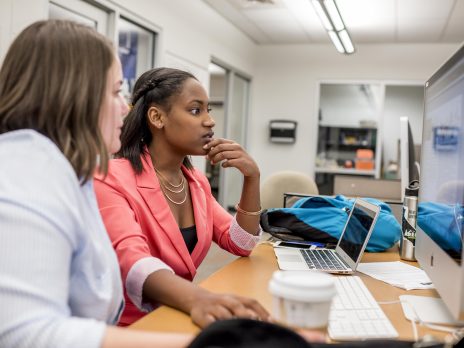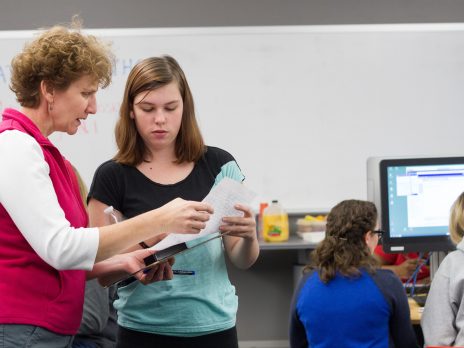Questions?
Check LMC Lab availability
About the Lumberjack Mathematics Center (LMC)
LMC Policy FAQs
Can I come to the LMC for in-person help? Accordion Closed
The LMC is open for the following courses: MAT 100, MAT 108, MAT 114, and MAT 125. See our Hours and Location page for current operating hours.
What if I need help with other math courses? Accordion Closed
Tutoring for other math courses, including MAT 121, MAT 136, MAT 137, MAT 238, STA 270, etc., is provided by the Academic Success Centers.
Is the LMC Testing Room Open? Accordion Closed
The LMC Testing Room is open to students in the following courses: MAT 100, MAT 108, MAT 114, and MAT 125. See the table below for operating hours.
| Fall 2024 | Times |
|---|---|
| Monday, Wednesday, and Friday | 10:30 am to 2:30 pm |
| Tuesday and Thursday | 1:30 pm to 5:30 pm |
| Saturday and Sunday | CLOSED |
You can also visit our Testing Room page for more information.
What are my in-person attendance requirements for LMC courses? Accordion Closed
See your LMC course syllabus or contact your instructor regarding specific attendance questions.
What about Lab time and attendance minutes? Accordion Closed
Each LMC course is unique and has its own lab attendance requirements. See your LMC course syllabus for Lab attendance requirements.
How can I get help for my LMC course? Accordion Closed
- You can visit the LMC Lab for in-person tutoring and support.
- You can schedule a one-on-one tutoring appointment with a Math Jack at the LMC front desk. Appointments times offered are below—there is one appointment per time and appointments are subject to availability.
| Monday | Tuesday | Wednesday | Thurdsay | Friday |
|---|---|---|---|---|
| 10-10:45 am | 10-10:45 am | 10-10:45 am | 10-10:45 am | 10-10:45 am |
| 11-11:45 am | 11-11:45 am | 11-11:45 am | 11-11:45 am | 11-11:45 am |
| 12-12:45 pm | 12-12:45 pm | 12-12:45 pm | 12-12:45 pm | 12-12:45 pm |
| 1-1:45 pm | 1-1:45 pm | 1-1:45 pm | 1-1:45 pm | 1-1:45 pm |
| 2-2:45 pm | 2-2:45 pm | 2-2:45 pm | 2-2:45 pm | 2-2:45 pm |
| 3-3:45 pm | 3-3:45 pm | 3-3:45 pm | 3-3:45 pm | |
| 4-4:45 pm | 4-4:45 pm | 4-4:45 pm | 4-4:45 pm | |
| 5-5:45 pm | 5-5:45 pm | 5-5:45 pm | 5-5:45 pm | |
| 6-6:45 pm | 6-6:45 pm | 6-6:45 pm | 6-6:45 pm |
- You can attend your instructor’s office hours or schedule a meeting with them.
- You can contact the Academic Success Centers to schedule a one-on-one appointment.
LMC math course details
The Department of Mathematics and Statistics has redesigned four of its first-year mathematics courses to help students master course content. These courses will combine in-class instruction with lab time in the Lumberjack Mathematics Center, where students have access to valuable resources, including instructors and math tutors.
MAT 100 Accordion Closed
In MAT 100 students have one required weekly meeting in the lab room using the most current and innovative software. Students spend the rest of their required time in the Lumberjack Mathematics Center. Instructors, tutors, and software help tools are available to provide immediate assistance.
MAT 108 Accordion Closed
In MAT 108 students have two required weekly class meetings. One class meeting takes place in a classroom in which they explore some of the core concepts in groups through lessons and hands-on activities. The other class meeting takes places in the Lumberjack Mathematics Center Lab where they work in ALEKS. Students are also required to log 60 minutes each week outside of class time in the Lumberjack Mathematics Center Lab.
MAT 114 Accordion Closed
MAT 114 students meet twice a week: one day in the classroom and the other day in the LMC Lab. Students can choose to complete their assignments in the Lumberjack Mathematics Center.
MAT 125 Accordion Closed
In MAT 125 students have three required weekly meetings in a classroom in which they explore some of the core concepts in groups through lessons and hands-on activities. Students spend the rest of their required time using the most current and innovative software in the Lumberjack Mathematics Center. Instructors, tutors, and software help tools are available to provide immediate assistance.
More information Accordion Closed
Students in the newly redesigned classes spend time in the Lumberjack Mathematics Center Lab outside of their regular scheduled class times. Instructors and tutors are available at all times in the LMC Lab to help students.
The Lumberjack Mathematics Center has over 300 computers and is located in the brand new Student and Academic Services building. There are quiet study rooms and comfortable seating areas for students to enjoy outside of the classrooms and Lab.
Course design philosophy Accordion Closed
Students in our newly designed courses learn by doing mathematics – a lot of mathematics. Research has shown that the essence of learning is doing, rather than passively listening. [1]
Former President Haeger called for instructional innovation to better address the way that today’s students learn. He believes that effective use of technology is a key tool in increasing student retention and success. In his September 14, 2011 Campus Address he announced a new project for freshman mathematics courses: a mathematics course redesign using an emporium model.
National Center for Academic Transformation (NCAT) characteristics and goals Accordion Closed
The new course design is based guidelines from the National Center for Academic Transformation (NCAT). The NCAT has worked with several universities nationwide on course redesign. They estimate that over 160,000 students have participated in one of the 120 redesigned courses. They report that course redesign:
- improves student learning
- increases course completion
- improves retention
- improves students’ attitudes toward the subject
- increases student satisfaction with the mode of instruction
NCAT characteristics and goals for a new course design, which we follow, include:
- restructuring of the whole course, not just a single class
- emphasizing active learning – greater student engagement with the material and one another
- relying heavily on readily available interactive software, used independently and in teams
- mastery learning – it is not self-paced; there are deadlines
- increasing on-demand, individualized assistance from instructors, tutors, and software
- automating only components that can benefit from automation (e.g., homework, quizzes, exams)
- replacing a single mode of instruction with several different types
- enhancing quality by individualizing instruction
- assessing students’ knowledge in much smaller units
- providing feedback and direction to allow students to make up for specific deficiencies
- giving students help numerous hours per week
- improving the course as it proceeds
We would like to add our own goals to this list:
- improving mathematics learning
- helping students succeed in subsequent courses
[1] Thiel, Teresa; Peterman, Shahla; Brown, Monica. Addressing the Crisis in College Mathematics: Designing Courses for Student Success. Change, Jul/Aug2008, Vol. 40 Issue 4, p44-49, 6pIn an era when students can easily grab material online, including lectures by gifted speakers in every field, a learning environment that avoids courses completely—or seriously reshapes them—might produce a very effective new form of college.


